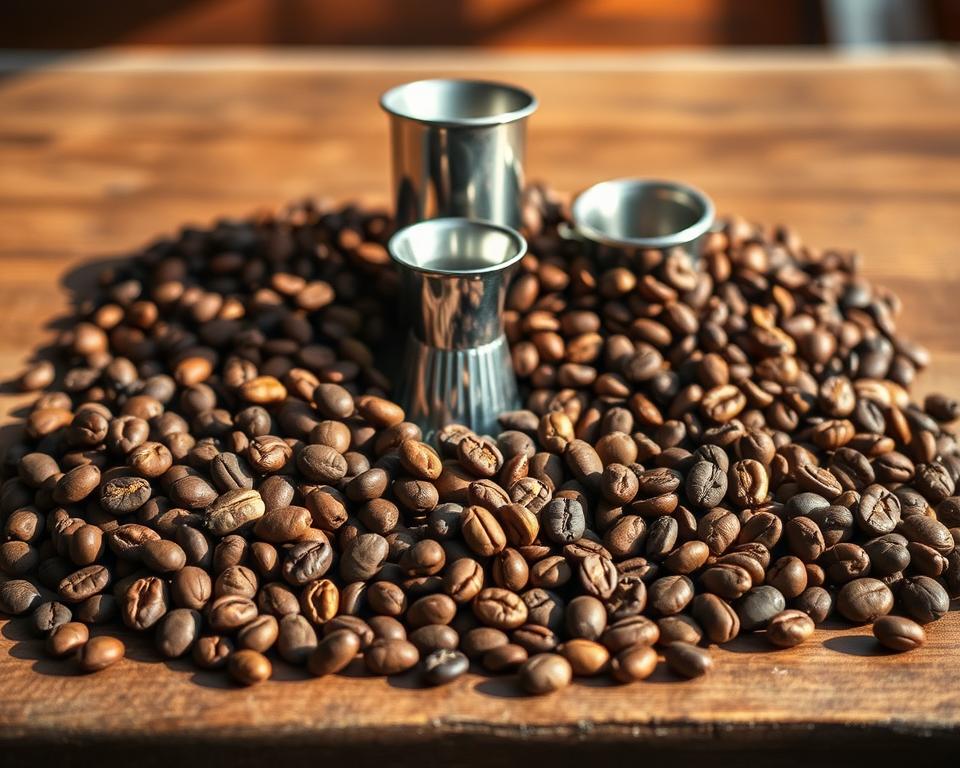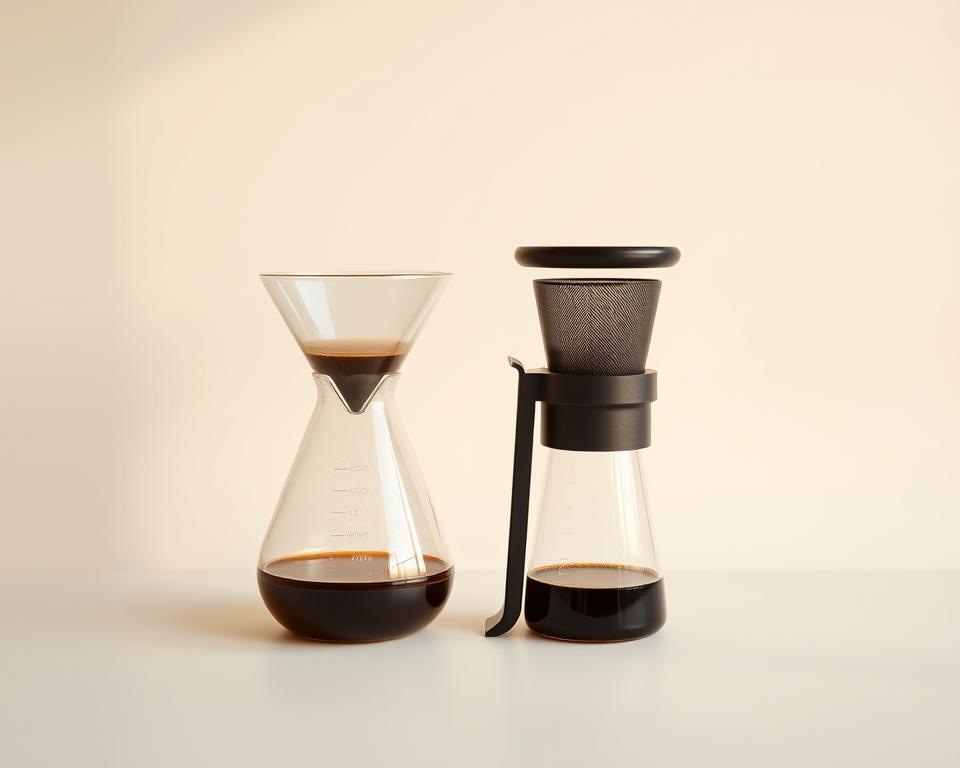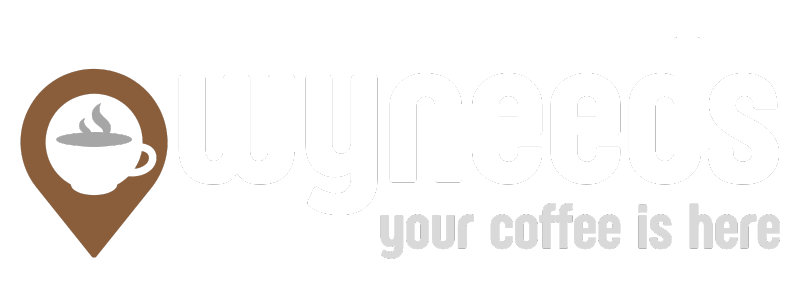Coffee brewing methods have seen a significant evolution, offering diverse ways to enjoy specialty coffee. The Chemex, created in 1941, is a timeless classic known for its clean, crisp cups. It uses thick paper filters. On the other hand, the Aeropress, introduced in 2005, employs air pressure to produce rich, full-bodied coffee in a short time. Both methods stand out in the specialty coffee world, blending tradition with innovation.
These tools cater to different preferences, from portability to flavor. The Chemex’s glass design allows for brewing up to 8 cups at once. In contrast, the Aeropress’s compact size makes it perfect for travel. Sustainability is also a consideration, with Chemex’s eco-friendly filters contrasting with Aeropress’s reusable options. Which one fits your lifestyle better? Let’s dive in.
Key Takeaways
- Chemex, created in 1941, uses thick filters for clean, smooth coffee at $40–$50.
- Aeropress, invented in 2005, brews quickly with pressure, costing just $30 and $0.02 per filter.
- Chemex emphasizes tradition with glassware, while Aeropress prioritizes portability and versatility.
- Aeropress brews stronger caffeine than Chemex but lacks its crisp acidity.
- Both methods support eco-friendly practices through reusable or biodegradable filters.
Introduction to Coffee Brewing Methods
Coffee is more than a morning boost; it’s a journey of discovery. Each brewing method, from pour-over to French press, reveals unique flavors. By exploring different ways to brew coffee, you can customize your taste to match your mood. Curious about the science behind it? Check out Counter Culture Coffee’s guide to start.
Why Explore Different Brewing Methods?
Each technique dramatically shapes flavor. How to brew coffee is crucial: a French press’s coarse grind emphasizes body, while AeroPress’s quick steep highlights acidity. Through experimentation, you discover your preference.
- Coarse grinds in French presses create robust flavors.
- Fine grinds for espresso make intense shots in 25 seconds.
- Pour-over methods let you control water flow for nuanced tastes.
A Brief History of Coffee Brewing
Coffee’s journey started in Ethiopia, where coffee cherries were roasted and boiled. By the 1600s, Turkish coffee used finely ground beans. The 1800s introduced French presses and espresso machines. Today, innovations like AeroPress and Chemex dominate home bars.
The Rise of Specialty Coffee
Third-wave coffee culture transformed brewing into an art form. Cafes now celebrate origin and technique. Chemex’s glass carafes and AeroPress’ portability are modern favorites. Specialty roasters like Counter Culture Coffee emphasize precision, proving brewing is a craft, not just a routine.
Overview of Chemex
The Chemex brewer is a blend of art and science, standing as one of the most iconic coffee brewing methods. Its elegant hourglass design, crafted from heat-resistant borosilicate glass, is complemented by a wooden collar and leather tie. This makes it a focal point in any kitchen. Its timeless appeal has even earned it a place at the Museum of Modern Art, showcasing its status as both a statement piece and a functional tool.
What is Chemex Brewing?
Chemex employs a pour-over technique with uniquely thick filters. These filters effectively trap more oils, resulting in a clean, crisp flavor. The brewing process involves pouring hot water (94–96°C) in stages, beginning with a 30-second bloom. This method yields a bright, balanced cup that accentuates coffee’s natural notes.
Unique Features of Chemex
- Material: Tempered glass withstands temperature changes without cracking.
- Filters: 20–30% thicker than standard paper, reducing bitterness.
- Capacity: Brews 2–4 cups (300–720g of water) with a 1:16 coffee-to water ratio.
Pros and Cons of Chemex
| Pros | Cons |
|---|---|
| Artistic design doubles as decor | Fragile glass requires care |
| Clean flavor from thick filters | Specific filters needed (e.g., Chemex #6 filters at $16/pack) |
| Temperature control with a goos kettle like the Fellow Stagg ($79) | Longer brew time (4–5 minutes) than methods like Aeropress |
For those who appreciate both aesthetics and flavor clarity, the Chemex stands out. Its premium quality comes at a price, starting at $43.50. Yet, the experience it offers is well worth the investment for coffee brewing enthusiasts.
Overview of Aeropress
Introduced in 2004 by Alan Adler, the AeroPress blends simplicity with innovation in coffee brewing techniques. This compact device leverages air pressure to extract rich flavors, becoming a favorite for both home and travel use. It’s perfect for those seeking versatility, producing coffee of café quality in under three minutes.
What is Aeropress Brewing?
Aeropress brewing combines immersion and pressure methods. It involves mixing coffee and hot water (175°F) in the cylindrical chamber, steeping for 1 minute. Then, pressing the plunger filters the coffee through a microfilter. The Counter Culture Coffee guide showcases techniques like the “inverted method” for deeper extraction, highlighting its adaptability.
Unique Features of Aeropress
- Portable design: Weighs under 10 ounces, fits in a backpack.
- Pressure-based extraction: Reduces bitterness by using pressure to shorten brew time.
- Filter compatibility: Works with paper, metal, or cloth filters.
The AeroPress has a minimalist setup with just three parts: a plastic chamber, plunger, and filter cap. Its versatility is evident in recipes like the “World Barista Championship-winning method,” which uses a 1:6 coffee-to-water ratio for espresso-like intensity.
Pros and Cons of Aeropress
Pros: Produces smooth, full-bodied cups with less acidity than French Press. Cleans in seconds. Affordable at under $40. Cons: Smaller yield (1–3 cups) and limited filter options compared to Chemex.
The AeroPress adapts to any best coffee brewing methods experiment, whether camping or crafting pour-over-style coffee. Its 65,000+ global reviews underscore its status as a go-to for both baristas and beginners.
Comparing Chemex and Aeropress
Choosing between Chemex and Aeropress? Let’s examine their distinct qualities. Each brewing method adds a unique flavor to your day.
Flavor Profiles of Each Method
- Chemex produces light, sweet coffee with a tea-like clarity. Its bright acidity and floral notes are enhanced by paper filters.
- Aeropress, on the other hand, offers bold, velvety flavors with low acidity. Its immersion method brings out rich cocoa and nutty tones.
Brewing Time: Chemex vs. Aeropress
Speed is crucial:
- Chemex requires 5-7 minutes, including precise pour-over steps.
- Aeropress, by contrast, finishes in 3-4 minutes, perfect for those in a hurry.
Ease of Use: Which is More Convenient?
Aeropress is simpler to use:
- It eliminates the need for complex pour patterns, making it straightforward to enjoy.
- Chemex, while elegant, demands more practice to master its pour-over technique.
Both methods use paper filters for clean, oil-free coffee. Your choice should reflect your taste, time constraints, and brewing preferences.
Equipment and Accessories Needed
Mastering different ways to brew coffee begins with the right tools. Let’s explore the essential coffee brewing equipment for both methods.
What You’ll Need for Chemex Brewing
- Chemex brewer (choose glass or carafe size)
- Chemex paper filters (pre-wet to reduce wood pulp taste)
- Gooseneck kettle (like Bonavita Variable Temp) for controlled pouring
- Burr grinder (e.g., Baratza Encore) set to medium-coarse grind
- Digital scale and timer for precise measurements
Aeropress Essentials
- Aeropress brewer (includes plunger and chamber)
- Paper filters or reusable metal discs (included in kit)
- Standard kettle (gooseneck optional)
- Grinder (blade or burr) adjusted to fine grind
- Optional extras: travel lid, funnel, or insulated mug adapter
Top Brands for Brewing Tools
Invest in quality gear to elevate your brew:
- Kettles: Bonavita Variable Temp for precision
- Grinders: Baratza Encore (burr) or Capresso Infinity (blade)
- Accessories: Acaia Pearl scale or Fellow Stagg EKG thermometer
- Filters: Chemex brand paper vs. Aeropress’s reusable metal discs
Start with the basics: a grinder, brewer, and scale. Add extras like timers or specialized kettles as your budget grows. Each tool listed here is versatile, allowing you to experiment with various brewing methods.
Coffee Beans: The Right Choice for Each Method
Choosing the right beans can make or break your brew. Let’s explore how to match coffee beans with specialty coffee brewing methods to get the best results.

Best Coffee Beans for Chemex
Chemex shines with light to medium roasts that highlight bright acidity and floral or fruity notes. Look for single-origin beans from Ethiopia or Colombia. For example, Stumptown’s Daylight Roast or Intelligentsia’s Ethiopian Yirgacheffe bring out clarity and complexity. A home roasting guide can help you perfect these profiles. Opt for beans priced around $37–$47 for 12 oz bags to ensure quality.
Best Coffee Beans for Aeropress
Aeropress excels with medium to dark roasts. Roasts like Counter Culture’s Big Trouble or Verve Coffee’s Hologram deliver rich chocolate or caramel flavors. Their medium-dark profiles handle the Aeropress’s pressure without bitterness.
Grind Size: How It Affects Flavor
- Chemex needs a medium-coarse grind (like sea salt) to avoid over-extraction.
- Aeropress uses a medium-fine grind (sugar-like) for even extraction under pressure.
Misaligned grinds can ruin your brew. Too fine for Chemex leads to bitterness; too coarse for Aeropress weakens flavor. Use a burr grinder for consistency.
Brewing Techniques and Tips
Mastering coffee brewing techniques unlocks the full potential of your favorite beans. Whether you’re using a Chemex or Aeropress, these methods require precision. Let’s dive into step-by-step guides and common pitfalls to avoid.
Step-by-Step Guide for Chemex
- Pre-wet the filter with hot water to eliminate paper taste.
- Combine 30g medium-coarse grounds (like kosher salt) with 500ml water at 200°F.
- Pour slowly in circular motions for a 3-minute bloom, ensuring even extraction.
Step-by-Step Guide for Aeropress
Choose between standard or inverted methods:
- Standard: Add 16g medium-fine grounds, brew for 1 minute, then plunge.
- Inverted: Flip the device, steep for 1-3 minutes, then press down gently.
Both methods achieve clean, crisp flavors in under 2 minutes.
Common Mistakes to Avoid
- Wrong water temperature: Use 200°F for Chemex; 195–205°F for Aeropress.
- Incorrect grind size: Chemex needs medium-coarse; Aeropress prefers medium-fine.
- Neglecting pre-wetting filters: This step prevents off-flavors in pour-over methods.
For popular coffee brewing methods like these, consistency is key. Always clean equipment and store beans in airtight containers to preserve freshness. Experiment, adjust ratios, and enjoy the process!
Environmental Considerations
Choosing eco-friendly coffee brewing equipment begins with understanding each method’s environmental impact. Both Chemex and Aeropress offer paths toward sustainability. Yet, small choices significantly influence our environmental footprint. Let’s examine how materials and habits contribute to greener brewing.
Is Chemex More Sustainable?
- Chemex’s glass body and wood collar utilize renewable resources.
- Compostable paper filters reduce single-use waste.
- With proper care, Chemex lasts for years, reducing replacement needs.
Is Aeropress Environmentally Friendly?
- Its plastic body is durable but less recyclable than glass.
- Metal mesh filters eliminate paper waste.
- AeroPress Clear uses tougher Tritan plastic, enhancing longevity.
Reducing Your Coffee Carbon Footprint
Small steps can make a significant difference. Here are some tips:
- Swap paper filters for metal in pour-over or Aeropress setups.
- Compost spent grounds—rich in nitrogen, they boost gardens.
- Choose shade-grown or organic beans to support ethical farming.
- Use a gooseneck kettle to boil only needed water, saving energy.
| Brewing Method | Materials | Water Use | Waste | Energy |
|---|---|---|---|---|
| French Press | Glass/stainless | Moderate | No disposable filters | Low (no heat after brewing) |
| Aeropress | Plastic/mesh filter | Low | Near-zero | Moderate |
| Chemex | Glass/wood | Moderate | Paper filters | Moderate |
| Cold Brew | Glass/pitcher | Low | Near-zero | Negligible |

Every brew choice has an impact. Whether opting for low-energy French Press or sustainable Chemex with compostable filters, small changes accumulate. Explore options that align with your values!
Conclusion: Which Method is Right for You?
Exploring Coffee Brewing Methods is about finding what suits your lifestyle and taste. Both Chemex and Aeropress deliver exceptional results but cater to different preferences. Let’s break down how to decide.
Personal Preference and Taste
If you crave a quick brew with travel-friendly versatility, the AeroPress shines. Its compact design and ability to make cold brew or espresso-style drinks adapt to your routine. Chemex fans love its glass clarity and elegant pour-over ritual, perfect for those valuing presentation. Taste preferences matter most here—try both to see which flavor profile suits you best.
Experimenting with Both Methods
Many enthusiasts keep both brewers. The AeroPress is popular worldwide for its convenience, while Chemex is recognized for its design legacy. Borrow a friend’s gear or visit cafes to test before buying. Specialty coffee brewing methods like these thrive on experimentation, so don’t hesitate to mix and match.
Final Thoughts on Coffee Brewing Methods
Specialty coffee brewing methods open doors to endless discovery. Whether you prioritize speed, aesthetics, or flavor depth, both tools excel in their own ways. Remember, even classics like French press and drip have their place. The key is matching your choices to your daily life. With practice, each brew becomes a chance to enjoy exactly as it is.
FAQ
What are some popular coffee brewing methods?
How do I choose the best coffee brewing method for me?
What makes the Chemex unique?
What are the key features of the Aeropress?
How do the flavor profiles differ between Chemex and Aeropress?
What equipment do I need to brew with Chemex?
What accessories can enhance my Aeropress experience?
What type of coffee beans should I use for each method?
Any tips for brewing with Chemex or Aeropress?
How can I make my coffee brewing more environmentally friendly?

Paul Allen is a writer at WyNeeds, a website dedicated to the world of coffee. Passionate about aromas and flavors, he explores everything from the best brewing methods to fascinating insights about coffee beans and industry trends. His goal is to provide readers with engaging and informative content, helping both beginners and coffee enthusiasts deepen their knowledge of the world’s most beloved beverage.

